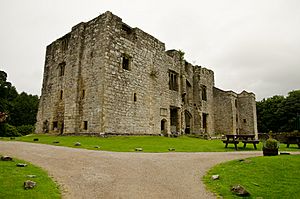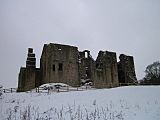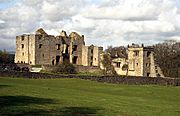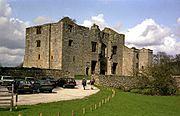Barden Tower facts for kids
Quick facts for kids Barden Tower |
|
|---|---|

Barden Tower
|
|
| Type | Fortified House |
| Location | Barden, North Yorkshire |
| Nearest city | Bradford, West Yorkshire |
| OS grid reference | SE050572 |
| Elevation | 492 feet (150 m) |
| Founded | c.1485-1490 |
| Founder | Henry Clifford |
| Restored | c.1678 |
| Restored by | Anne Clifford |
| Current use | Tower derelict House used as cafe |
| Owner | Bolton Abbey Estate |
| Lua error in Module:Location_map at line 420: attempt to index field 'wikibase' (a nil value). | |
Barden Tower is an old, ruined building in a beautiful area called Wharfedale, in North Yorkshire, England. It was used as a hunting lodge in the 1400s and 1500s. Even after being fixed up in the 1650s, it slowly became a ruin in the 1700s.
Today, Barden Tower is part of the Bolton Estate. It is known as a medieval fortified tower. Many people visit the tower, and it's a key spot on the 100-mile long-distance path called Lady Anne's Way.
Contents
History of Barden Tower
Where is Barden Tower Located?
The tower is about 4 miles from Bolton Bridge to the south and the village of Burnsall to the north. It sits in the middle of these two places.
Who Built Barden Tower?
There was a small lodge in the Barden Forest long ago. But the stone tower we see today was rebuilt around 1485–1490. It was built by Henry Clifford, 10th Baron Clifford, who was also known as the Lord Shepherd.
Henry Clifford chose Barden as his main home instead of his larger Skipton Castle. Barden Tower was one of six hunting lodges owned by the Clifford family. These lodges were used between the 1300s and 1600s. The tower became a central point for the small villages and farms nearby. It was like a community hub.
When Was the Tower Repaired?
The tower, along with a chapel next to it and Skipton Castle, was repaired by Lady Anne Clifford in the 1650s. The tower's roof had been damaged during the English Civil War. People believe the first roof was made of thatch.
In the 1500s and 1600s, other buildings like a farmhouse and a chapel were built next to the tower. The priest's house, built around 1513, was likely for Henry Clifford's private chaplain. After Lady Anne died in 1676, the tower was taken over by the Earls of Cork. It then started to fall apart in the 1700s and has been a ruin for over 200 years.
Barden Tower During a Time of Conflict
During the Jacobite rising of 1745, a group of soldiers stayed at the tower. They were there to protect the area if the Scottish army came through. About 150 men with spears, staffs, and axes were at the tower. Even though the Jacobite Army did travel through Yorkshire, Barden Tower was not involved in any fights.
Life Around the Tower in Later Years
The tower's second roof, made of lead, was removed around 1800. But the buildings still remained important to the local people. This became even easier after Barden Bridge opened in 1659.
There was a school and a chapel at the site. Both were used well into the 1900s. The chapel was last used for Christian worship in the 1960s. While baptisms and burials were not allowed at the chapel, marriages were performed there.
Barden Tower Today
In 1954, all three historic buildings at the site were given a "Grade I listed" status. This means they are very important historical buildings. The Priesthouse part of the buildings was turned into a restaurant and wedding venue in 2016.
The entire area around the tower, including the land and the buildings, is listed as an ancient monument. It is a popular place for tourists and visitors. It is easy to find from the walking paths in the area, especially those along the River Wharfe.
Images for kids






